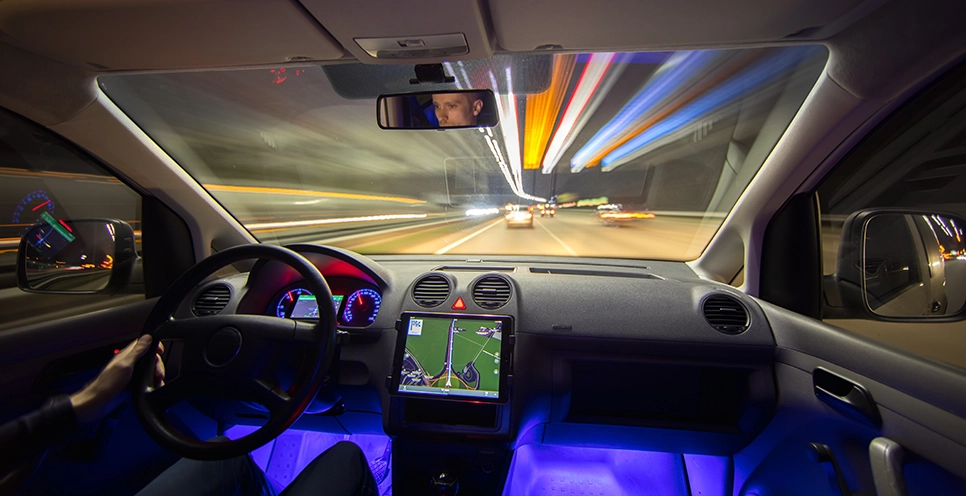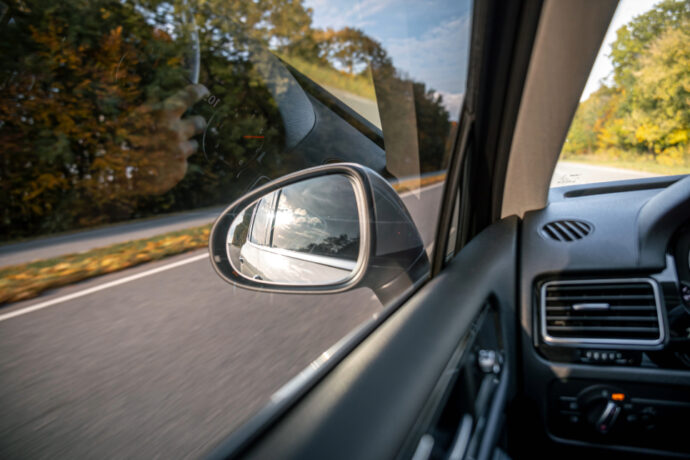In the world of modern automotive technology, ADAS calibration has become an important yet often misunderstood aspect of vehicle maintenance. But what exactly is it, and why should you care?
Buckle up because we’re about to take a deep dive into the world of Advanced Driver Assistance Systems (ADAS) and why keeping them properly calibrated is vital for your safety on the road.
What is ADAS Calibration?
Let’s start with the basics. ADAS stands for Advanced Driver Assistance Systems. These are the high-tech features in modern cars that help keep you safe on the road. Think of things like adaptive cruise control, lane departure warnings, and automatic emergency braking.
ADAS calibration is the process of making sure all these advanced systems are working correctly. It’s like giving your car’s brain a tune-up to ensure it’s seeing and interpreting the world around it accurately.
ADAS components include a variety of sensors and cameras that work together to create a comprehensive safety system. These might include forward-facing camera sensors, rear radar sensors, and steering angle sensors. Each of these ADAS sensors plays a necessary role in gathering real-time data about your vehicle’s surroundings and other vehicles on the road.
When is ADAS Calibration Necessary?
There are several situations where ADAS calibration becomes vital:
- After a windshield replacement
- Following a collision or accident
- When you’ve had work done on your car’s suspension or steering
- If you’ve noticed your ADAS features acting wonky
Let’s break these down a bit more.
Windshield Replacement and ADAS Calibration
Many ADAS sensors are located behind the windshield. So, when you get a new windshield, even a tiny misalignment can throw off these sensors. That’s why it’s important to get your ADAS calibrated after any windshield work.
Post-Accident Calibration
Been in a fender bender? Even minor accidents can knock your sensors out of whack. It’s always a good idea to get your ADAS checked and calibrated after any collision, no matter how small.
Suspension and Steering Work
Your car’s ADAS relies on knowing exactly where it is in relation to the road. Any changes to your suspension or steering can alter this relationship, making calibration necessary.
When Your ADAS is Acting Up
If you notice your lane departure warning going off when you’re in the middle of your lane, or your adaptive cruise control behaving erratically, it’s time for a calibration check.
What are the Benefits of ADAS Calibration?
Now that we know when to do it, let’s talk about why it’s so important. Proper ADAS calibration offers several key benefits:
- Enhanced Safety: Correctly calibrated systems can react faster and more accurately to potential dangers on the road.
- Improved Performance: Your car’s ADAS features will work as intended, providing a smoother, more enjoyable driving experience.
- Avoiding False Alarms: Poorly calibrated systems might trigger warnings when there’s no real danger, which can be annoying and distracting.
- Prolonged System Life: Regular calibration can help extend the lifespan of your ADAS components.
- Peace of Mind: Knowing your safety systems are in top shape gives you confidence on the road.
Types of ADAS Calibration: Static vs. Dynamic
When it comes to ADAS calibration, there are two main types: static and dynamic. Let’s break them down.
What is ADAS Static Calibration?
Static calibration is like taking your car to the optometrist. It’s done in a controlled environment, usually a workshop, with the car stationary. Here’s how it works:
- The car is parked on a level surface.
- Special targets are set up at precise distances and angles from the vehicle.
- A scan tool is connected to the car’s computer.
- The technician follows a specific procedure to calibrate each sensor.
Static calibration is often used for forward-facing camera sensors, radar sensors, and 360-degree camera systems.
What is ADAS Dynamic Calibration?
Dynamic calibration, on the other hand, is more like taking your car for a test drive. As the name suggests, it’s done while the vehicle is in motion. Here are the basic steps involved:
- A scan tool is connected to the car’s computer.
- The vehicle is driven on a road with clear lane markings.
- The car must be driven at specific speeds for a set distance.
- The ADAS systems calibrate themselves using the real-world environment.
Dynamic calibration is often used for systems like lane departure warnings and adaptive cruise control.
The choice between static calibrations and dynamic calibrations often depends on the specific ADAS components being calibrated and the manufacturer specifications. For instance, calibrating forward radar sensors or adjusting the steering wheel angle might require different approaches.
How Often Should ADAS Be Calibrated?
There’s no one-size-fits-all answer to this question. It really depends on your vehicle and how you use it. However, here are some general guidelines:
- After any event mentioned earlier (windshield replacement, accident, suspension work)
- If you notice any issues with your ADAS features
- Some manufacturers recommend calibration during regular service intervals. These intervals vary from, for example, every 24 or 36 months or at 30,000 or 50,000 miles.
It’s always best to check your vehicle’s manual or consult with a professional to determine the right calibration schedule for your specific car. Your driving habits, the conditions you typically drive in, and any modifications to your vehicle can all affect how often calibration is needed.
What Happens if ADAS is Not Calibrated Correctly?
Skipping ADAS calibration or having it done incorrectly can lead to some serious issues:
- False Alarms: Your car might warn you of dangers that aren’t there.
- Missed Warnings: Even worse, your car might fail to warn you of real dangers.
- Incorrect Responses: Systems like automatic emergency braking might activate at the wrong times.
- Reduced Effectiveness: Your ADAS features simply won’t work as well as they should.
Remember, these systems are designed to keep you safe. When they’re not calibrated correctly, it’s like driving with a blindfold on – not something you want to risk!
How Long Does ADAS Calibration Take?
The time it takes to calibrate your ADAS can vary widely depending on your vehicle and the type of calibration needed. Here’s a rough breakdown:
- Static calibration: Usually takes 1-3 hours
- Dynamic calibration: Can take 30 minutes to an hour of driving time
- Some vehicles require both static and dynamic calibration
Keep in mind that these are just estimates. Your specific vehicle might take more or less time.
Can I Do ADAS Calibration Myself?
While it might be tempting to try a DIY approach, ADAS calibration is not a job for the average car owner. Here’s why:
- Specialized Equipment: Proper calibration requires expensive, specialized tools that most folks don’t have in their garage.
- Technical Knowledge: ADAS calibration procedures can be complex and vary significantly between vehicle makes and models.
- Precision Required: Even tiny errors in calibration can lead to big problems down the road.
- Safety Concerns: Incorrectly calibrated ADAS can create dangerous situations while driving.
Given these factors, it’s best to leave ADAS calibration to the professionals.
What Equipment is Needed for ADAS Calibration?
ADAS calibration requires some pretty sophisticated gear. Here’s a basic list:
- Diagnostic scan tool
- Calibration targets
- Alignment rack
- Manufacturer-specific tools
- Level floor space
- Precise measuring tools
The exact equipment needed can vary depending on the make and model of your vehicle.
The ADAS calibration equipment used by professionals is highly sophisticated and often includes special tools designed for specific vehicle makes and models. This might include reflective surfaces for camera calibration, pre-scan and post-scan tools to assess the system before and after calibration, and OEM-recommended devices to ensure precise ADAS calibration.
How Do I Calibrate an ADAS System?
While we don’t recommend trying this at home, it’s good to understand the basic process. Here’s a simplified overview:
- Connect a Scan Tool: This communicates with your car’s computer.
- Set Up Targets: For static calibration, precise targets are positioned around the vehicle.
- Follow Procedures: Each car model has specific calibration procedures.
- Perform Dynamic Calibration: If required, the car is driven under specific conditions.
- Verify Calibration: The technician checks that all systems are working correctly.
Remember, this is a simplified version. Professional technicians undergo extensive training to perform these procedures correctly.
During the calibration process, technicians must account for various factors that could affect the system’s performance. This includes ensuring the front bumper is in good condition (as many sensors are located here), checking that the vehicle’s year and model are correctly identified in the calibration software, and verifying that all ADAS technologies are functioning correctly after calibration.
Does ADAS Need Calibration After a Wheel Alignment?
In most cases, yes. Wheel alignment can change the orientation of your vehicle’s sensors relative to the road. This is particularly important for systems that rely on knowing the car’s exact position, like lane departure warnings.
Does ADAS Need Calibration After a Windshield Replacement?
Yes. Many ADAS sensors, particularly forward-facing cameras, are mounted on the windshield. Even a slight change in the windshield’s position can throw off these sensors. Always get your ADAS calibrated after windshield replacement.
Does ADAS Need Calibration After an Accident?
Yes, even minor accidents can affect your ADAS. The sensors are very sensitive, and even small shifts in their position can impact their performance. It’s always better to be safe and get your ADAS checked and calibrated after any collision.
How Much Does ADAS Calibration Cost?
The cost of ADAS calibration can vary widely depending on several factors:
- Your vehicle make and model
- The type of calibration needed (static, dynamic, or both)
- The number of systems that need calibration
- Your location
On average, you might expect to pay anywhere from $250 to $600 for ADAS calibration. Some high-end vehicles with complex systems might cost even more.
While this might seem steep, remember that you’re paying for specialized equipment, technical expertise, and most importantly, your safety on the road.
How Do I Find a Qualified Technician to Perform ADAS Calibration?
Finding the right technician for ADAS calibration is very important. Here are some tips:
- Check Certifications: Look for technicians certified in ADAS calibration.
- Ask About Equipment: Make sure they have the right tools for your specific vehicle.
- Read Reviews: See what other customers have to say about their experiences.
- Inquire About Experience: Ask how long they’ve been performing ADAS calibrations.
- Verify Warranty: Ensure their work is guaranteed.
Remember, the cheapest option isn’t always the best when it comes to something as important as ADAS calibration.
The Impact of Advanced Driver Assistance Systems on Vehicle Safety
It’s worth noting that ADAS significantly reduces the risk of accidents on the road. These advanced driver assistance systems have revolutionized the automotive industry, automatically adjusting various aspects of your drive to keep you safe. From maintaining a safe distance from other cars to alerting you about vehicles in your blind spot, ADAS technologies are constantly working to prevent collisions.
However, for these systems to function correctly and provide optimal vehicle safety, proper calibration is essential. Even a small misalignment due to human error during calibration could compromise the effectiveness of these safety features. This is why calibration should always be performed by trained professionals in an ADAS calibration center, following manufacturer specifications to the letter.
The Importance of ADAS Calibration
ADAS calibration might seem like just another car maintenance task, but it’s so much more than that. It’s about ensuring that the advanced safety systems in your vehicle are working precisely as they should, keeping you and your loved ones safe on the road.
From understanding when ADAS calibration is necessary to knowing what to expect during the process, we hope this guide has given you a comprehensive overview of ADAS calibration. Remember, these systems are designed to assist you, not replace your judgment as a driver. Always stay alert and drive safely!
Remember, your vehicle’s safety systems are only as good as their calibration. Regular maintenance, including ADAS calibration, is vital for ensuring these advanced systems continue to protect you on the road. Whether you’re navigating through your city’s busy streets or cruising on the highway, properly calibrated ADAS components work tirelessly to keep you safe, analyzing your vehicle’s surroundings and making split-second decisions to prevent accidents.
As automotive technology continues to advance, we can expect even more sophisticated ADAS systems in modern vehicles. These developments in the automotive industry will likely lead to even greater emphasis on precise calibration techniques and specialized calibration equipment. Stay informed about your vehicle’s ADAS features and calibration requirements to ensure you’re getting the most out of these life-saving technologies.
At Precision Auto Glass, we’re committed to staying at the forefront of these advancements. Our technicians are trained in the latest calibration processes and equipped with state-of-the-art ADAS calibration equipment. We understand that your safety and satisfaction are paramount, which is why we adhere strictly to OEM recommendations and industry best practices in all our calibration work.
So, next time you’re due for ADAS calibration, need a windshield replacement, or auto glass in the Denver area, don’t hesitate to reach out to us at Precision Auto Glass.




